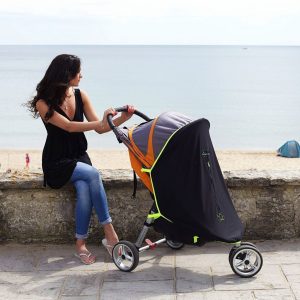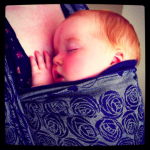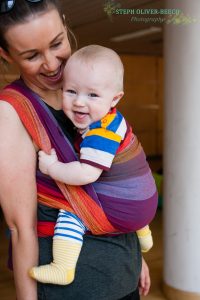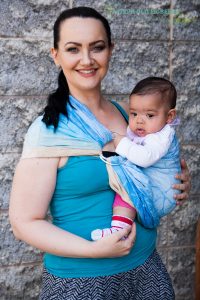How Young Can You Put a Baby Forward Facing in Carrier

What are the advantages of world-facing?
Babies do enjoy seeing the world, especially once they are a little older and have mastered head control and wish to be more involved with their environment, rather than sleeping or snuggling in as they did when they were very footling. Curiosity ofttimes coincides with increased motor co-ordination and greater periods of awake and interaction time. This is oftentimes the indicate at which families brainstorm holding their babies in positions that give them greater visibility. Instinctively, they tend to support their niggling ones in very gentle positions that still ensure good hip and spine back up; cradled in artillery with chin off breast, or held in semi-seated positions with back curved against parent merely hips held in flexion, as if sitting in a bowl.
These positions protect the natural anatomical curve of the immature spine and do non straighten information technology uncomfortably.
As babies grow, their muscle forcefulness increases and fatiguability decreases, aslope greater coordination and gross motor skills. This allows slowly improving head and neck and upper back control (with less drooping or wild flailing) as their spines gradually brainstorm to uncurl. Furthermore, as their focal length improves and visual acuity rises, the world becomes very interesting! At that place are stages in baby development when babies seem to curvation abroad in arms a lot; this may be related to a want to meet more, simply may also merely exist attempts to strop upper back strength, in preparation for turning skills and rolling over. This is very common around x to twelve weeks. Babies may also curvation when they are tired, if they have reflux, if they are frustrated.
In-artillery property is responsive, which is the fundamental issue; if baby makes a protesting motility or noise, the carer responds and moves the infant to help it to get at-home once again. Also, parental arms get tired and baby is hands moved to another position, this may often be on the shoulder facing parent again for a while. Such reactive carrying in-arms, with changing facing-in and facing-out positions, is of great benefit for honing development and also to encourage learning about the world from a rubber and comfortable position.
This all sounds great, so what's the trouble with using a sling for this?
What are the hazards of facing out?
 Information technology is important to remember that immature babies are not set for prolonged and intense interaction with a very sensory-overloading environs; they have non yet learned how to process the bombardment of data their brains are receiving. They have not however discovered how to "filter out" the irrelevant for a more focused look at the world, (a skill that we take for granted) so this can be very tiring. Being able to plough away from the dissonance and bustle and autumn comatose (to process data) is of import. A facing-out carrier holds a infant in a fixed position for a prolonged period of fourth dimension. The duration of this time is entirely dependent on the parent; they are unable to come across their babe'south face to pick up early cues of tiredness or distress or breathing difficulties, and they are less able to feel subtle shifts in babe'south torso signalling discomfort or a need to change positions. Babies can hands be left in carriers for much longer than they would exist held in arms.
Information technology is important to remember that immature babies are not set for prolonged and intense interaction with a very sensory-overloading environs; they have non yet learned how to process the bombardment of data their brains are receiving. They have not however discovered how to "filter out" the irrelevant for a more focused look at the world, (a skill that we take for granted) so this can be very tiring. Being able to plough away from the dissonance and bustle and autumn comatose (to process data) is of import. A facing-out carrier holds a infant in a fixed position for a prolonged period of fourth dimension. The duration of this time is entirely dependent on the parent; they are unable to come across their babe'south face to pick up early cues of tiredness or distress or breathing difficulties, and they are less able to feel subtle shifts in babe'south torso signalling discomfort or a need to change positions. Babies can hands be left in carriers for much longer than they would exist held in arms.
Babies are intensely social creatures and learn to regulate and control their emotions from interaction with their parents and watching their faces. Social referencing (also known equally triangulation) is very important in the commencement year and well into the second. A child will often decide how to react to a new experience after it has looked to its carer; it will be less likely to touch something dangerous if the carer reacts in an upset way. Potentially scary experiences can defused past turning the head to see a parent remaining at-home, or to receive comfort and reassurance, and vice versa. In a structured carrier worn facing out, it isn't as easy for a baby to twist effectually to see the parent'south face for reassurance or to be able to seek comfort.
 Many pushchair makers now include parent-facing positions as standard, as this is believed to encourage and better linguistic communication skills and bonding. (It is worth noting that in that location is no formal show to suggest that our children are any slower at linguistic communication conquering than previous generations who did non apply facing-out means of transport, even so, anything that promotes bonding and advice is to exist encouraged.)
Many pushchair makers now include parent-facing positions as standard, as this is believed to encourage and better linguistic communication skills and bonding. (It is worth noting that in that location is no formal show to suggest that our children are any slower at linguistic communication conquering than previous generations who did non apply facing-out means of transport, even so, anything that promotes bonding and advice is to exist encouraged.)
Furthermore, the globe-facing positions do not provide any condom sleeping positions (all respected manufacturers say babies must be turned effectually to sleep; this is frequently missed in the pocket-sized print) as in that location is no head support in this carry. A heavy head that is unsupported by a parent'south chest volition droop forwards, putting baby's chest nether slight compression and pressing the chin downwards, potentially compromising the airway.
This is why the bulk of respected sling manufacturers propose that babies under 4months should non be carried facing out. Before this, babies simply are non developmentally ready. Beyond this age, they should non be held in carriers facing the earth for longer than 20 minutes to half an hour or so. (Some manufacturers say facing out from 3 months upwards, some say from 5months up). I call back it depends on the kid's personal developmental stage and there should really be no blitz.)
There is also the issue of hip and spine positioning in facing out positions. Most facing out in slings is washed with "narrow-based" carriers, as very few high street options offer wider, more ergonomic seats that protect the gentle curve of the spine and promote healthy hip development in the world facing position. Well-nigh babies find their backs are held in straighter positions than ideal, with their legs hanging straight downwardly from their hip sockets in this narrow shaping. While there is no formal show that choosing a narrow-based carrier volition crusade whatever harm to a babe who has good for you hips with normal sockets, there is a small percentage of babies who do have developmental hip dysplasia that are missed at their routine checks. These babies will benefit enormously from the ergonomic seated One thousand shape position that allows their joints to be held in the optimum angles for healthy claret vessel growth and nutrient provision, and often this positioning is all that is needed to right mild cases of hip dysplasia. It is worth weighing upward the risks and may be better to choose a carrier that holds a baby more optimally if you decide to face baby out. Additionally, it is more comfy for a person to be seated on a broad based hammock shaped chair rather than perched astride a narrow padded axle, and babies are no different.

Carrying a babe who is sitting high upward against the carer's torso with the centres of gravity closely aligned is much more comfortable than carrying one who is low down, far away, and suspended from the carer's shoulders. The parent's body does not form part of the support construction of the deport when facing out, so much of the work of carrying has to be done past the upper body, rather than the core postural muscles. Centres of gravity diverge farther when held facing out in narrow based carriers. Put but, conveying facing out in this style of carrier is often uncomfortable.
Ok, then what can I employ to carry my curious child optimally?
Information technology is common among parents who are considering using a sling to look for options that offer world-facing positions. This position is what is often seen in the media and is widely advertised; it may be more pleasing to run into happy babies looking directly at the camera rather than away from it, which can be better for marketing purposes. As it is then visible, it becomes the "norm" and carriers that offering this selection are often perceived as "better."

Many parents believe that babies need to be given the opportunity to face the world as much as possible for the stimulation, rather than looking at their parent all the time. Sometimes this belief can be exist a marker for low self-esteem in a parent; that they merely aren't interesting plenty, when in fact, for many well-attached babies, their parent is their well-nigh dear sight. This is particularly true if parent and baby are attuned and the parent is responsive and communicative and able to appoint happily in play with their baby. Babies are often able to selection up on unhappy or uneasy feelings in parents and can be reflexively resistant to shut contact, creating a negative spiral. Lots of in-arms conveying, skin to skin, and simply fourth dimension spent together can be very helpful with this.
Sometimes babies may begin to resist existence carried in their parent-facing positions – they may have come to acquaintance the sling with sleeping which they don't want to practise, and they may want to be able to see more than.

To achieve a proficient view while the child remains parent-facing, and ensure access to the earth, effort carriers with broadly angled straps that don't go too close to the confront tin be very useful, or ones that can exist tied carefully for expert visibility. As children grow in co-ordination, they need less head support and ofttimes enjoy having their arms out of carriers (with the panel reaching up to the armpits for rubber and back up.) Information technology is surprising how far a child tin turn round to see when they can movement their shoulders! 
If y'all take a infant who is developmentally prepare for facing out in a carrier and has stable hips, then I think it is but fine to give it a go! Your local sling library will be able to show you some options and talk you through which may exist the most comfortable for you. Trying the carrier out first for a flow of time at home is very useful to see if it really does work for you before y'all buy; advice from the cyberspace is no substitute for existent life trials.This period of "fussiness" doesn't commonly concluding long, as babies grow in co-ordination they are happier and many babies who once resisted facing in are very content a few months afterward in a carrier that is more than comfortable with greater longevity.
In summary, facing out can exist a corking deal of fun for parent and kid, if done sensitively and thoughtfully, with consideration to the kid's anatomical development and comfort; look for those carriers that take your baby's comfort as seriously as yours. Try to choice a carrier that will hold baby optimally for most of the time, some come with specially designed saucepan seats and others will widen for facing in and dorsum carrying.
Age-advisable facing out for those who savor it is great, when washed safely! Your local sling library tin can be found at www.slingpages.co.britain.
Source: https://www.carryingmatters.co.uk/the-fuss-about-facing-out/
0 Response to "How Young Can You Put a Baby Forward Facing in Carrier"
Post a Comment